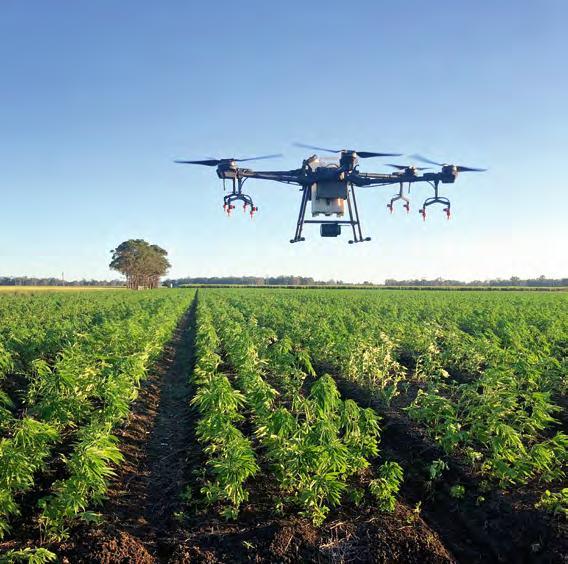
Why Hemp is a Game-Changer for Regenerative Agriculture in Broadacre Farming
Share
Introduction:
As the need for sustainable farming practices grows, regenerative agriculture is emerging as a leading solution to restore soil health, increase biodiversity, and combat climate change. At the heart of this movement is hemp, a versatile and resilient crop that offers numerous benefits for broadacre farming programs. In this post, we’ll explore why hemp is a powerful tool in regenerative agriculture, focusing on its ability to improve yields of subsequent crops, enhance soil biology, and sequester carbon.
Hemp in Regenerative Agriculture: An Overview
Hemp is a unique crop that plays a crucial role in regenerative agriculture. Unlike conventional farming methods that deplete soil nutrients and degrade the land, regenerative agriculture aims to restore and enhance the ecosystem. Hemp contributes to this by building up the soil's organic matter, improving its structure, and fostering a rich soil biology that benefits other crops planted in the same field.
Hemp Improving Yields of Subsequent Crops
One of the key advantages of incorporating hemp into a broadacre farming program is its ability to improve the yields of crops planted after it. Hemp's deep root system not only helps to break up compacted soil, but it also brings nutrients from deeper layers of the earth up to the surface, making them more accessible to subsequent crops. This natural tilling effect, combined with the organic matter left behind by hemp, creates a fertile environment for the next planting season.
Studies have shown that fields previously planted with hemp can experience increased yields in crops such as wheat, barley, and legumes. This is largely due to the improved soil structure and enhanced microbial activity that hemp cultivation promotes.
Biomass Left Under the Soil: A Boost for Soil Biology and Carbon Sequestration
Hemp is renowned for producing large amounts of biomass, both above and below the ground. After the hemp crop is harvested, the roots and any remaining plant material contribute to the organic matter in the soil. This biomass serves as a vital source of carbon and nutrients for soil organisms, which in turn helps to improve soil fertility and structure.
The root biomass left under the soil after a hemp crop can be substantial. Estimates suggest that hemp can contribute between 1 to 2 tonnes of root biomass per hectare. This biomass not only enriches the soil but also plays a significant role in carbon sequestration. As the plant material decomposes, carbon is stored in the soil, helping to mitigate climate change by reducing the amount of CO2 in the atmosphere.
The Importance of Retting Hemp Leaves into the Soil
Allowing hemp leaves to naturally rett into the soil is another practice that can greatly benefit regenerative agriculture. Retting is the process by which hemp leaves decompose and release their nutrients back into the soil. This process enhances soil fertility and supports the growth of healthy, resilient crops.
It is estimated that hemp can produce up to 1,500 kg of leaves per hectare. These leaves are rich in nutrients such as nitrogen, potassium, and phosphorus, which are essential for plant growth. By allowing hemp leaves to rett into the soil, farmers can significantly boost the nutrient content of their fields, reducing the need for synthetic fertilizers and promoting a more sustainable farming system.
Potential Nutrient Content of Hemp Leaves:
- **Nitrogen (N):** Approximately 2-4% of the dry weight of hemp leaves is nitrogen, a crucial nutrient for plant growth and photosynthesis.
- **Potassium (K):** Hemp leaves are also high in potassium, which supports plant health, water regulation, and resistance to diseases.
- **Phosphorus (P):** Phosphorus, present in smaller amounts, is vital for energy transfer and root development in plants.
These nutrients are gradually released into the soil as the hemp leaves decompose, providing a slow-release source of nourishment for subsequent crops. This not only enhances soil fertility but also supports the principles of regenerative agriculture by minimizing the need for external inputs and fostering a self-sustaining ecosystem.
Conclusion:
Hemp is an invaluable crop for regenerative agriculture in broadacre farming programs. Its ability to improve soil structure, enhance soil biology, and sequester carbon makes it a key player in the transition towards more sustainable farming practices. By incorporating hemp into crop rotations and allowing its leaves to rett into the soil, farmers can boost the fertility of their fields, increase crop yields, and contribute to the fight against climate change. As regenerative agriculture continues to gain momentum, hemp will undoubtedly play a central role in creating healthier, more resilient agricultural systems.
